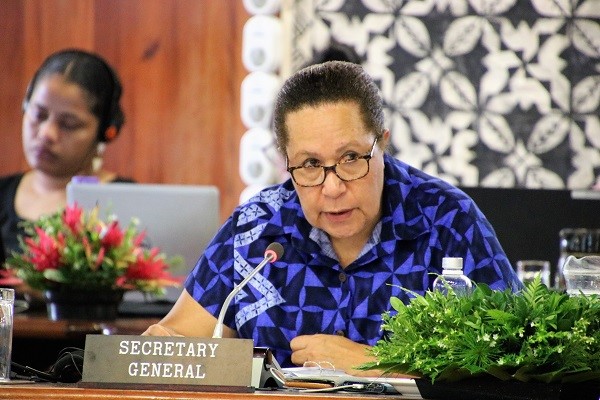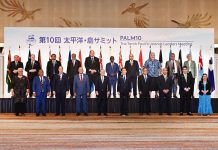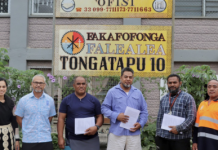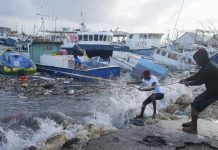By Dame Meg Taylor, Non-Resident Distinguished fellow for the Blue Pacific, Asia Society Policy Institute
Today’s geopolitical circumstance, defined by the rivalry between the United States and China, has redefined the dynamics of regional and global orders.
This reality is palpable in the Pacific region, where the strategic interests of major powers and their allies intersect and undermine our own aspirations for a “united ocean of peace.” This paper explores the challenges Pacific-led regionalism faces as it grapples with this evolving external power dynamic alongside our own internal challenges of unity.
While I have faith in the resilience of our region, demonstrated at so many points in our history, our regional unity is deeply challenged and undermined by the encroaching influence of competing geopolitical agendas. It has never been clearer that the Blue Pacific identity holds paramount importance. Through a collective identity that allows us to shape our own narrative and guide our own aspirations, we, the people of the Blue Pacific, can navigate these complex geopolitical times together to stand for peace.
Geopolitics Through Blue Pacific Eyes
All the world’s regions are experiencing some degree of burden from the fierce geopolitical competition between the United States and China. It is useful to start this paper with a brief discussion of how this competition is experienced in the Pacific.
We can sense the United States and its allies, in particular Australia, grappling with the challenge China presents to the West’s established position in the region. Motivated by a geostrategic calculation that China poses a credible threat to their supremacy, the United States and its allies have adopted aggressive and conspicuous measures to safeguard their positions. These measures center on the construct of a “free and open Indo-Pacific” that seeks the strategic denial of China and works toward solidifying a regional and global order built around U.S. supremacy.
The free and open Indo-Pacific is an act of imagination. It is underpinned by strong rhetoric that depicts China as an aggressor that uses military and economic coercion to bully and projects the United States as the leader of the free and open democratic order across a super-region from the United States to Africa. It is also a material act. We are experiencing the U.S attempt to revitalise its dormant relationships with our states and societies and observe it reinforcing its alliances with countries such as Australia, Japan, India, Indonesia, the Philippines, and Singapore.
While we hear of a range of new economic, development, and environmental programs and policies that exclude China, we experience the primary geostrategic focus as defense. The Indo-Pacific was crafted within defense circles and is oriented toward defence initiatives. At its center, the AUKUS (Australia, United Kingdom, United States) partnership, which was announced unexpectedly, caused unease across a region that prides itself on working toward a demilitarised, peaceful Pacific and a world free of nuclear weapons. And at its spokes, Defense Cooperation Agreements being pursued with our nations are creating internal tensions and frustration at the lack of a broader debate in Pacific states around the significant control and access being granted to foreign powers.
We also believe China is pursuing its Grand National Strategy to displace the United States as a regional and global hegemon. Motivated by its own geostrategic calculations about a declining West, we are experiencing China’s efforts through its initiatives, including the Belt and Road Initiative (BRI), Community of Shared Destiny, Global Security Initiative (GSI), and now the Global Development Initiative (GDI).
China’s initiatives are also acts of imagination. They are underpinned by rhetoric that depicts the West as colonial and their insistence on the international rules-based order as chauvinism. China projects itself to us as a south-south partner, an alternative, and as proof that modernization does not have to equal Westernization. Its initiatives are also material. While its strategy has security (including the establishment of new military bases and modernization of the Peoples Liberation Army (PLA)) and political elements, we are experiencing the primary geostrategic focus through increased investment in our infrastructure and our people.
Amid the strategies of these great powers, we, the Blue Pacific nations and people, continue to advance our own interests. So often “belittled” as having an insignificant position, in fact, we regularly punch well above our weight. Motivated by our own calculations of both the risks and opportunities this geostrategic context presents for us, we have defined our own regional order. We have identified a Blue Pacific Continent, which positions us as a strategically important site of independence, sovereignty, and peace — an order in which we remain “friends to all,” an order of peace, an order of unity in our diversity.
The Blue Pacific, too, is ideational. Our rhetoric is steeped in the self-empowerment, self-determination, and regional solidarity of Hau’ofa’s expansive “Our Sea of Islands.” This essay emphasises our “ocean identity” as the inseparable link between us and the ocean’s geography and resources. Placing the Blue Pacific at the heart of policymaking and collective action fosters unity and collaboration across the region. As Tarcisius Kabutaulaka notes, it is also an exercise in counter mapping, one that pushes not only against and challenges the dominant views of us as small and vulnerable but also against the geostrategic narratives that surround us. However, it is also material. We have hundreds of regional institutions and civil society groups implementing countless regional treaties, declarations, and strategies.
Our Challenge — Control and Unity
Pacific-led and Pacific-defined regional order faces two significant challenges.
The first is to retain control.
China’s growing presence and position in the Pacific have been driven by proactive economic involvement and complex commercial investments at the national level that filled a void left by our traditional western-aligned partners — Australia, New Zealand, the United States, United Kingdom, Europe, and Japan. China’s success has been achieved through aligning with our interests. Its ability to deliver, while far from perfect, has garnered support among the many Pacific Island nations. As argued by Anna Powles, China’s recent shift from bilateral to regional engagement underscores its increasing confidence in its political capital across Pacific nations. Although China’s first attempt to shift the regional order through a regional and economic agreement failed, this recalibration toward regional engagement continues, demonstrated by the announcement of the China–Pacific Island Countries Climate Action Cooperation Center as one of 32 initiatives to kick-start its new GDI. As Pete Connolly observed, even modest Chinese interests can wield significant influence given the profound asymmetry of our economies.
At the regional level, rather than seeking to surpass China’s improved position by also delivering on our development agenda, the response from the United States and its allies has been to subsume our narrative under their own geostrategic framework of strategic denial. Initiatives like the “Partners of the Blue Pacific” were implemented without our consultation, riding roughshod over our institutions and arrangements to exclude China as a key development partner. While the original Indo-Pacific Strategy only mentions the Pacific Islands Forum once in passing, the Forum with U.S. ally, Australia, a full member, now sits at the center of U.S. strategy on engaging with the Pacific.
The fact that our complex regional architecture is not politically or economically sovereign only compounds this challenge. Our inner circle, the Council of Regional Organisations of the Pacific, remains heavily reliant on external funds, and we still have former colonial powers — the United States, France, Australia, United Kingdom, and New Zealand — sitting as full members at our decision-making tables. While we have made strides in setting our own regional agenda, our ability to take this forward remains reliant on the support of our partners. Through the substantial economic capital they possess when compared to that of our nations, they are able to exert considerable influence on our agenda through what is resourced and what is not. The outer circle is made up of a range of other institutions, such as regional offices of UN agencies and multilateral banks, some that bring resources to the region, but many that compete for our already limited pool.
The second challenge is to retain unity.
Our ability to collectively manage and navigate geopolitical complexities in our own interests has varied throughout history. Like the tides, we have had moments in which we have surged forward to assert ourselves collectively, shown constituent unity, and demonstrated our ever-growing adeptness by acting as a group in challenging the imbalanced power structures that affect us. Then there are moments when we have retreated, when our national interests have prevailed over our regional ones, when internal tensions have emerged, and when we have allowed external actors to shape our regional agenda. Are we now in one of these moments?
Unity is no easy task. We are a diverse configuration of nation-states from politically but not always economically independent island nations, associated and compact states, a third of the world’s remaining colonial territories, and two industrialised Western settler-colonial states. Our interests and perspectives are varied, and we grapple with a continuous oscillation between unity and fragmentation. Some Pacific Islands Forum members prioritise relationships with powerful states such as the United States, China,
and France, at the expense of broader Pacific affiliations. This hierarchy of allegiances compromises the unity of the Pacific community and raises questions about inclusivity and independent decision-making. The equilibrium between pursuing individual national agendas and fostering collective action under geostrategic pressure is challenging to say the least.
Regional tensions can also hinder our unity when nations or subregions prioritise their agendas over broader collective interests. Language and cultural biases, along with resource disparities, impact fair representation and further strain unity. Complexities in staff makeup and geographic realities within regional organisations complicate the notion of equal representation, as some nations have more extensive resources and accessibility. The starkest example of this internal discord was the recent rupture that resulted in the Micronesia almost withdrawing from the Forum.
Pacific Regionalism: From Undermined to Reinforced
Geopolitical pressure is undermining our ability to manage the dual challenges of retaining control and retaining unity. While our narrative remains strong, our unity and control are being tested. While we have clearly articulated our needs and aspirations through a 2050 Strategy, our partners continue to work toward their own self-interests. We need to see the challenges and implications in front of us clearly and focus in on them if we are to remain in control and unified. I see three issues we must keep in the forefront of our minds, our debates, and our actions.
The first is clear: the “regional orders” of Great Powers compete with our own.
Consolidating our own narrative of self-determination and sovereignty amid the competing narratives put forth is a formidable task. At the heart of this task is understanding the fundamental incompatibilities of the narratives at play that we are being pushed to choose from.
The Indo-Pacific strategy is incompatible with Blue Pacific priorities and values. While its architects argue that it aims to promote strategic equilibrium in the Pacific, as Greg Fry has pointed out, it really aims to create the conditions for continuing Western hegemony. It seeks to deny China a role as an economic partner to the region, in opposition to our interests of remaining friends to all in pursuit of a self-determined future. It is a traditional, defense-centric understanding of security that sits in stark contrast to our broader definition that recognizes the expanded concept of security that includes human security, economic security, humanitarian assistance, environmental security, cybersecurity, and transnational crime, as well as regional cooperation to build resilience to disasters and climate change. The pursuit of AUKUS without reference to the Blue Pacific’s firm and long-standing opposition to militarization further damages any arguments for complementarity.
China’s own Grand Strategy to displace U.S hegemony does not speak to the Blue Pacific narrative either and is clearly incompatible with the region’s values. There are cultural tensions with China, particularly concerning local business initiatives that some people believe the Chinese population is trying to take over. Anti-colonial and economic narratives, on the other hand, resonate with the Pacific’s own political and economic self-determination ambitions.
However, the most notable disparity between the geostrategic agendas of the United States and China gathers around our most pressing concern: the planet’s climate crisis. Clearly engaged in a competition for influence, both countries continue to prioritize geopolitical dominance and economic interests over the paramount challenge of climate change. This glaring misalignment between the global powers’ narratives and the Pacific’s imperatives underscores the challenge of aligning the region’s narrative with those that revolve around geopolitical rivalry.
The second issue is the need to oppose the manipulations and distractions that we face.
We know we are a part of the world in which superpowers and others think they can manipulate, distract, and define us due to our economic dependencies and internal complexities. We have a great deal of experience in managing this pragmatically. We weigh our own interests in light of what is being offered; we have decades of experience when it comes to UN votes; we know exactly how much a seat on the Security Council is worth. But we are still highly susceptible to being picked off one by one as seen by successful recent diplomatic efforts by Japan to create cracks in our position of opposition to the dumping of nuclear waste.
But as China and the United States vie for influence, our ability to leverage these interactions in our favor is growing more complicated, and the stakes are too high. The power imbalances are too stark, the impact is far more consequential, and the tactics are growing more aggressive. As Joanne Wallis argued, escalating strategic competition in the Pacific can create divisions between as well as within our nations.
We are at risk of losing the control we have of our regional architecture. While we have engaged during the past few years in internal debates around power within the Pacific Island Forum, the architects of the Indo-Pacific strategy, as noted by Marueen Penjueli, have shifted their “encircling strategy” from Pacific Rim countries to tightening their grip on the Pacific Islands themselves. Our divisions create space for the major powers to advance their own interests over ours in the Indo-Pacific, as evidenced by the United States using our own narrative to create new regional institutions, such as the Partners of the Blue Pacific.
The U.S assessment that a weakened Forum works in China’s favour has led to increased support to hold things together, but the result is that we have created a structure that is unworkable and unaffordable. Of course, we all want offices in various parts of the Pacific, but they need to work and that requires the ability to resource them. Pacific regionalism does not have its own means to fund new institutions and structures, so this is coming from richer countries that will be increasingly able to influence our institutions to deliver their own agendas.
The Forum is only 50 years old. It is an institution that is growing and changing; while this is positive, it also means that we are open to manipulation by stronger powers. A more dependent architecture will continue to create a dependency mentality that suits all superpowers as well as those powers closer to home.
Finally, we need to keep both eyes focused on militarisation and dependency.
While increased funds could be leveraged to support the Pacific’s development agenda, it seems more likely, as Sandra Tarte concluded, that the cacophony of narratives and the strategic competition between the major powers could in the long term be counterproductive to achieving the region’s climate change goals and development ambitions.
The risk lies in the distraction from the Pacific’s own agenda and diversion of funds. While our communities demand greater funding for climate action, we do not see that even a fraction, as we noted as Pacific Elders, of the staggering US$368 billion allocated for AUKUS has been made available to deal with the climate crisis. Our Blue Pacific narrative has always sought to advance a region that is free from military competition — we believe that a more militarised region creates greater risks for our people. As China’s military modernizes further and the United States seeks to secure its territorial waters from east to west with military bases, it is our countries that become their buffers.
In its most recent budget, Australia announced an additional $36.8 million (US$23.7 billion) over four years to improve aid effectiveness and transparency alongside increased funding of $1.9 billion (US$1.2 billion) most of it not classified as aid) for security agencies, defense, the Australian Federal Police, and other agencies to work across the Pacific. We have come to see only too well how the dominance of the Indo-Pacific narrative can funnel resources away from investment in Blue Pacific interests and objectives. The current disingenuity from all on these matters will only fuel a deeper mistrust.
Conclusion: Rising to the Challenge
As the global power competition unfolds around us and we find ourselves caught in the crossfire between the United States and China, our focus must remain on control and unity of our own agenda, on the formidable challenge of the climate crisis, and the development of our region. Narratives of neither the United States nor China fully align with our own. While the powers fight over which really is the new imperial or the old imperial power, the result is the same for us: dependency and militarisation. I suggest five ways in which we can rise to the challenge.
1. Assert Our Identity and the Pacific Way
Sustaining the region’s friends-to-all approach is paramount to continuing to pragmatically engage with either side in a completely neutral manner to pursue the best interests of the Pacific Islands collectively. Amid pressures to choose sides, the Pacific must remain steadfast in welcoming partners who engage on its terms. If external powers attempt to undermine this, the Pacific must be prepared to redefine its inner circle, reserving it exclusively for independent Pacific Island states.
2. Remain Friends to All in an “Ocean of Peace”
Sustaining the region’s friends-to-all approach is paramount to continuing to pragmatically engage with either side in a completely neutral manner to pursue the best interests of the Pacific Islands collectively. Amid pressures to choose sides, the Pacific must remain steadfast in welcoming partners who engage on its terms. If external powers attempt to undermine this, the Pacific must be prepared to redefine its inner circle, reserving it exclusively for independent Pacific Island states.
3. Continue to Progress Reforms to Regionalism
If Pacific regionalism is to find a more stable footing, we must retain its focus on the path we have carved over the years. Anchored in reforms, visionary agendas, and strategic frameworks, including Sir Mekere Morauta’s leadership, politics, and inclusivity agenda, the Blue Pacific Narrative, and the Blue Pacific 2050 Strategy, the Pacific must confront its hurdles head on. Identifying and addressing governance, financing, geopolitical challenges, and subregional tensions are vital for realising the full potential of this regional agenda.
4. Ensure Partners Support Our Priorities
We must ensure our partners align with our agenda rather than letting them dictate our direction. Increased military involvement; expanding aid from Canberra, Washington, or Paris; and the rush for bilateral security agreements do not serve our interests. If the Blue Pacific and our 2050 Strategy, representing our people’s voices and concerns, are sidelined for other geopolitical priorities, it is our responsibility to hold partners accountable and shape the terms of engagement. We must not let geopolitics compromise our vision, whether from the United States, China, Australia, or others. Deep conversations and relationships are essential, not just superficial dictates. Our focus should be on the 2050 Strategy, an outcome of our collective efforts, now owned by Pacific nations and carried forward by our regional institutions. We cannot permit partners to selectively support what aligns with their interests.
5. Create Space for Our Own Leadership
The Pacific must assert its autonomy and creativity by urging partners, such as Australia and New Zealand, to allow space for local initiatives to breathe. While external assistance has its merits, it should not stifle local ingenuity. The emphasis should be on prioritising the region’s needs, particularly in addressing climate change impacts and economic development, rather than diverting focus through well-intentioned yet potentially disruptive interventions. It is crucial to recognise the Pacific’s historical strength in regionalism. Amid the wrangling of superpowers for dominance, the Pacific’s historical successes — from the movement for a Nuclear Free and Independent Pacific to collective protests against drift net fishing, we have shown unwavering commitment to safeguarding our home and capacity to navigate complexity while preserving sovereignty. The Pacific’s power lies in its ability to remain friends to all, fending off attempts to belittle us again. By remaining steadfast in its commitment to averting the climate crisis, the Pacific can assert its influence and contribute meaningfully to global challenges.
Pacific regionalism is at a crossroads, facing external narratives that often diverge from its core values. The Blue Pacific, an entity composed of sea, land, and people, is not just a narrative; it is a living reality, a reflection of the enduring spirit encapsulated by the Blue Pacific Ocean. The Blue Pacific narrative, transcending mere words to embody the region’s essence, exists as an ever-present reality shaped by the sea, land, and people, mirroring the ebb and flow of the Blue Pacific Ocean. It is an essence that remains unwavering in the face of disruptions, embodying the soul and spirit of the Pacific. As the Pacific nations strengthen their unity, seize opportunities, and face challenges with resolve, the essence of the Blue Pacific will guide them toward a future of self-determination, environmental resilience, and continued conversations begun by their ancestors.
SOURCE: ASPI/PACNEWS















